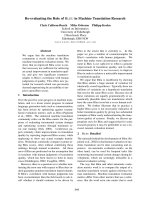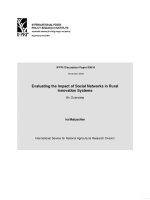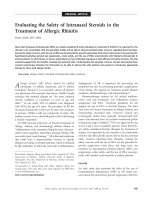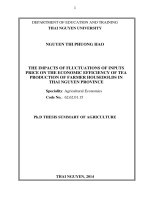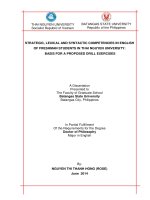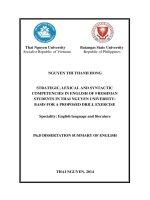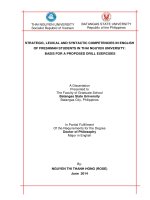Evaluating the implementation of unemployment insurance in thai nguyen province
Bạn đang xem bản rút gọn của tài liệu. Xem và tải ngay bản đầy đủ của tài liệu tại đây (734.36 KB, 122 trang )
EVALUATING THE IMPLEMENTATIONOF UNEMPLOYMENT
INSURANCEIN THAI NGUYEN PROVINCE
___________________________
A DISSERTATION
Presented to the Faculty of the Graduate School
Southern Luzon State University, Lucban, Quezon, Philippines
in Collaboration with
Thai Nguyen University, Socialist Republic of Vietnam
___________________________
In Partial Fulfilment
of the Requirements for the Degree
Doctor of Business Administration
___________________________
By
PHUNG THI CAM CHAU (ROSE)
December 2013
i
APPROVAL SHEET
The Dissertation of
PHUNG THI CAM CHAU
entitled
EVALUATING THE IMPLEMENTATION OF UNEMPLOYMENT
INSURANCE IN THAI NGUYEN PROVINCE
Submitted in Partial Fulfilment of the Requirements for the Degree
DOCTOR OF BUSINESS ADMINISTRATION
A program jointly offered by Southern Luzon State University,
Republic of the Philippines and Thai Nguyen University,
Socialist Republic of Vietnam
has been approved by Oral Examination Committee
WALBERTO A. MACARAAN, Ed.D.
Expert
CONRADO L. ABRAHAM, Ph.D.
Expert
MELCHOL MELO O. PLACINO, Ph.D.
Expert
TRAN DAI NGHIA, Ph. D.
External Panel
CECILIA N. GASCON,Ph.D.
Chairman
Endorsed by:
Recommended by:
DO ANH TAI, Ph.D.
Adviser
APOLONIA A. ESPINOSA, Ph.D.
Dean
Accepted in Partial Fulfilment of the Requirements for the Degree
Doctor of Business Administration
_____________________
Date
WALBERTO A. MACARAAN, Ed.D.
Vice President for Academic Affairs
ii
CERTIFICATE OF ORIGINALITY
iii
ACKNOWLEDGMENT
I would like to extend my sincere thanks to Thai Nguyen University
(Vietnam), International training center (Thai Nguyen University, College of
Agricultural and Forestry), Southern Luzon State University (Philippines) for
having organized this doctorate training course in business administration
training, which I have found to be a valuable opportunity for me to further
upgrade my knowledge and capacity.
I feel grateful for my lecturers who have provided their students with
their great knowledge and guidance throughout the course.
I am indebted to the administrators of Thai Nguyen College of
Economics and Finance, andVietnam Trade Union University for their
facilitation of my attendance to this course.
I owe my deep gratitude to Assoc. Prof. Dr. Do Anh Tai, my supervisor
and instructor, for his kind instructions and valuable remarks towards my
completion of this thesis.
I would also like to say thanks to my relatives, friends and colleagues.
Without their donations of materials, data processing, and translation, this
thesis would not have been made possible.
I am indebted to many other people. They are writers of useful
materials in books, internet, and newspapers.
And finally, my big thanks to my family whose encouragement and
support have always been with me from the beginning to completion of this
thesis.
iv
DEDICATION
I would like to dedicate this work to my parents, teachers, relatives, colleagues and
friends - who have been standing by my side, giving me support in life.
My first expression of gratitude comes to my parents who I own this life to and who
have been wholeheartedly supporting and facilitating me towards my achievements.
I am profoundly grateful to my teachers for their thoughtfulness and
dedication. My passion to sciences could not have growth without them.
I sincerely thank my relatives, friends and colleagues who have been around
with their cheers and encouragements.
Thank you all!
PhungThi Cam Chau
v
TABLE OF CONTENTS
PAGE
TITLE PAGE ………………………………………………………………..
i
APPROVAL SHEET ……………………………………………………….
ii
CERTIFICATE OF ORIGINALITY ………………………………………..
iii
ACKNOWLEDGEMENT …………………………………………………..
iv
DEDICATION ………………………………………………………………
v
TABLE OF CONTENTS …………………………………………………..
vi
LIST OF TABLES ………………………………………………………….
viii
LIST OF FIGURES ………………………………………………………...
ix
LIST OF APPENDICES …………………………………………………...
x
ABSTRACT …………………………………………………………………
xi
CHAPTER
I
II
III
INTRODUCTION
Introduction ………………………………………………….
1
Background of the Study …………………………………..
3
Statement of the Problem ………………………………….
5
Significance of the Study …………………………………..
6
Scope and Limitation of the Study ………………………..
8
Definition of Terms ………………………………………….
8
REVIEW OF LITERATURE ……………………………….
12
Conceptual Framework ………………………….…………
35
METHODOLOGY
Local of the Study …………………………………………..
37
Research Design ……………………………………………
41
Population and Sampling ……….………………………….
41
Research Instrumentation. …...…..…………………….….
42
Validation of the Instrument ……………………………….
43
Data Gathering Procedure …………………………………
43
Data Processing Method …………………………………..
45
vi
Statistical Treatment ………………………………………
45
IV
RESULTS AND DISCUSSIONS ………………………….
47
V
SUMMARY, CONCLUSION AND RECOMMENDATION
Summary of Findings ………………………………………
82
Conclusions …………………………………………………
89
Recommendations …………………………………………
91
REFERENCES ……………………………………………………………..
97
APPENDICES ……………………………………………………………...
100
CURRICULUM VITAE …………………………………………………….
107
vii
LIST OF TABLES
TABLE
PAGE
1
Profile of Respondents ………………………………………..
48
2
Respondents’ Perceptions on Implementation of UI in Thai
Nguyen Province in Terms of Coverage of UI ……………...
57
Implementation of UI in Thai Nguyen Province in Terms of
Coverage of UIBased on the Evaluation of the
Respondents have been Grouped …………………………...
58
Respondents’ Perception on Implementation of UI in Thai
Nguyen Province in Terms of Conditions for the Enjoyment of
UI …………………………………………………………………..
63
Implementation of UI in Thai Nguyen Province in Terms
ofConditions for the Enjoyment of UI Based on the Evaluation
of the Respondents have been Grouped ……………………
64
The Respondents’ Perception on Implementation of UI in
Thai Nguyen Province in Terms of UI fund …………………
67
Implementation of UI in Thai Nguyen Province in Terms of
UI Fund Based on the Evaluation of the Respondents have
been Grouped ………………………………………………….
68
The Respondents’ Perception on Implementation of UI in
Thai Nguyen Province in Terms of UI Regimes ……………
71
Implementation of UI in Thai Nguyen Province in Terms of
UI Regimes Based on the Evaluation of the Respondents
have been Grouped ……………………………………………
72
The Respondents’ Perception on Implementation of UI in
Thai Nguyen Province in Terms of Procedures for UI
Regimes ………………………………………………………...
76
Implementation of UI in Thai Nguyen Province in Terms of
Procedures for UI RegimesBased on the Evaluation of the
Respondents Have Been Grouped …………………………..
77
Implementation of UI in Thai Nguyen Province based on
the Evaluation of the Respondents have been Grouped ….
79
3
4
5
6
7
8
9
10
11
12
viii
LIST OF FIGURES
FIGURE
PAGE
1
Conceptual Framework …………………………………………
36
2
Map of Vietnam ………………………………………………….
39
3
Map of Thai Nguyen Province ………………………………….
40
ix
LIST OF APPENDICES
APPENDIX
PAGE
A
Letter of Request to the Respondents …………………….
101
B
Questionnaire ………………………………………………...
102
C
Tabulation and Computations of Data ……………………..
105
x
ABSTRACT
Title of Research
: EVALUATING THE IMPLEMENTATION OF
UNEMPLOYMENT INSURANCE IN THAI NGUYEN
PROVINCE
Researcher
: PHUNG THI CAM CHAU (ROSE)
Degree Conferred
: DOCTOR OF BUSINESS ADMINISTRATION
Name and Address
of Institution
: Southern Luzon State University Lucban, Quezon,
Philippines and Thai Nguyen University, Socialist
Republic of Vietnam
Adviser
: Dr. Do Anh Tai
Year Written
: 2013
______________________________________________________________
In Vietnam, unemployment insurance (UI), as a mode of social
insurance and a component of social security, has been built and was
officially implemented in 2009. A 4-year experience, the implementation in the
country,in general, and inThai Nguyenprovince,in particular, of this policy has
made significant achievements, but also has some limitations that should
soon be adjusted for this policy to be more effective. Given this observation,
this study, "Evaluating the implementation of Unemployment Insurance in Thai
Nguyen Province" aims to evaluatethe implementationof UI inThai Nguyen
province in 2012andpropose recommendations toimprovethe implementation
ofthe policy in the coming years. In solving the research problem mentioned
previously, this study has the following objectives: (1) describe the characteristics
of the respondents; (2) determine the perception of the respondents on the
implementation of UI in terms of: coverage of UI, conditions for enjoying UI, UI
fund, UI regimes, and procedures for UI regimes; (3) compare the perceived
implementation of the UI when the respondents are grouped in terms of type of
nit that employees had worked at before unemployment; and (4) propose
xi
recommendations to improve the implementation of UI in Thai Nguyen province
in the coming years.
In this study, the researcher useddescriptive method and utilized a
questionnaire as the main data gathering tool. From data collected on
performance statistics of UI in 2012 in Thai Nguyen, 348 employees who were
entitled to UI were chosen as respondents for the study.
Based on the results of the survey, the following findings were found:
current Unemployment Insuranceexhibits basic policy limitations in the
following areas: regulation on the coverage of UI; regulation on the conditions
for the enjoyment of UI; regulation on procedures for UI regimes. Aside from
these, there are identified gaps in the implementation of the UI policy,
especially in the following areas: limited propaganda and information
dissemination; lack of awareness on coverage, conditions of eligibility;
process and nature of contributions; incomplete knowledge on eligibility
requirements; and tedious processing of application for the insurance.
On
the
basis
of
these
findings,
the
study
proposes
some
recommendations to improve UI policy and the efficiency of its implementation
as follows: expand the coverage of UI; adjust the conditions for the enjoyment
of UI in favor of, than against, the workers; determine additional sanctions for
violations in terms of contribution to the UI fund; implement UI regimes,
especially vocational training and support to find work more efficiently; simplify
the process of UI regimes; strengthen policy advocacy of UI; improve the
responsibility oflabor agency, UI organizations, employers and employees in
terms ofprocedures for UI regimes.
xii
1
Chapter I
INTRODUCTION
Today, besides the development of all aspects, the world is faced with
many challenges of economic, political and social nature. Along with large
uncertainties
such
as
war,
violence,
crime,
social
inequality,
etc.,
unemployment is also becoming a hot concern, exceeding all matters of
common worries, especially when the economic financial crisis knock to each
individual, each household in each country.
Unemploymentaffectsnot
onlyemployeesand
their
families.
Unemploymentoflargenumbersof individualsalso havevery negativeimpacton
society: for individuals, forthe economy, for nations.
However, in market economies, unemployment is an inevitable
phenomenon. It means that if there is a market economy, there is still
unemployment. The problem posed is how to control the allowed
unemployment
rate.
According
toeconomists,
maintaining
acertainunemployment ratecanstimulateeconomic growth. Butunemployment
rateincreaseexceeding
the
permitted
levelwill
greatly
affectthesocio-
economicdevelopmentof the country. Becauseoftheimpactof scientific and
technologicalrevolutionandglobalization,unemployment
isworsening.
Unemploymentbecame one of the problematic issuesinlots ofcountries, which
influencesstrongly on the developmentandstability of economic, political and
social status ofeach country.Sogovernmentsshould haveresponse policiesto
resolvethese two issuesdepending ontheirconditionsin various periods. Among
these response policies is what economists term as unemployment insurance
2
or UI whicharebuilt orimproved in manycountriestoprotectworkersto avoid
feelings of uncertaintyabout theeconomyand society.
Whenworkerslose their jobs,theyloseincome. Hence, one of thepositive
solutionsis
to
investto
createnew
jobs.
However,
this
is
notalwayspossible.Sometimesputting more moneyinto a not so strongcapital
economycanlead toinflation andeconomic crisis, exacerbatingunemployment.
There isanother solutionto protectworkersavoiding theinadequacy oflost jobs,
so that society needsto give themarevenueto offsetincomelost by providingUI.
This
is
one
ofthe
measures
whichhave
beenof
interest
inmany
countriesbecauseitnot only ensureslifefor individualswhoare unemployed,but
also contributes tosocial stability. UIisthe process of formationand use
offundsthrough thefinancialcontributions ofthe employee, theemployerandwith
the helpof the state,in order to supportincomeof workersshouldtheylose their
jobs, enablingthem to findnew jobsin thelabor market. This hasimportant
implications
forindividualworkers
andcompanies,
contributingtobalancingrolein the economy, helping to decrease social
stresscaused byunemployment. Thatis one of thetoolsto implementsocial
securitypoliciesa country.
Since Vietnam has begun its switch to market economy and integration
into the world economy, besides the economic-social achievement it has been
experiencing, unemployment has been one of the very urgent problems. In
the labor market, labor supply is greater than labor demand. Every year,
around 1.1 to 1.2 million people enter the work force, but the labor’s
absorptive capacity of the economy is limited. In addition, there is shortage in
the number of trained, skilled or technical workers, and a lack of basic
3
training.This is the reason why unemployment or underemployment is
increasingly becoming severe. Thus, even though there is a need in the labor
market, the level of available workers do not meet the criteria of the available
job. Besides, in the process of industrialization, modernization and economic
restructuring and innovation, quite a huge number of workers, in many
different cases, have their work contracts terminated. Moreover, in the context
of economic crisis in recent years, many small and medium enterprises,
department accounting about 98% of enterprises in Vietnam, to cut staff,
proceed toor went bankrupt, leaving workers lose their jobs. The unemployed
workers fell into economic difficulties, depressed in spirit, very easy to fall into
evils. This effects to social order - security largely.
In this situation, UI, as a mode of social insurance and a component of
social security, has been built and was officially implemented in 2009.
Background of the Study
In Vietnam, the unemployment insurancepolicy wasformally adoptedin
January 1, 2009 under the provisions of the Law on Social Insurance which
was enacted in 2006 with the following main contents: coverage of UI;
conditions for the enjoyment of UI; UI fund; UI regimes; and procedures for UI
regimes.
UI is a policy that aims to assist the unemployed byreplacing or
partially offsetting the income workers lose due to unemployment and, more
importantly, support the unemployed by providing vocational training that
would aid the worker in finding job immediately and help them have a stable
income and life.
4
Nationwide, the total number of employees was 49.322 million in 2009,
nearly 50.393 million in 2010, over 51.398 million people in 2011. On the other
hand, the unemployment rate (calculated width in urban areas) was 4.60% in
2009, 4.29% in 2010, and 3.60% in 2011. Particularly in Thai Nguyen province,
the total number of employees was 665,652 in 2009; 677,070 in 2010; and
685,630 in 2011; unemployment rate (calculated width in urban areas) was
4.46% in 2009, 4.24% in 2010, and 3.75% in 2011.
These figures shows the number of people that might be affected by UI
policies of Thai Nguyen Province, as well as, across the country, especially in
urban areas where the population is quite large.
It is worth noting that during the first four years from its implementation,
the policy has made significant achievements, while at the same time not
discounting the fact that there have been some limitations that should be
addressed to further enhance the policy.
One of its successes can be said to be its immediate practice, adoption
and positive response that may be accounted toits direct and practical
impacts to both employers and employees. Additionally, it is seen to
contribute toensuringsocial securityin the countryin general, and Thai
Nguyenprovincein particular.
However,the implementationprocessof UIalsogenerate many problems
that need to be addressed. Some of these relatedissues includecoverage of UI,
conditions for the enjoyment of UI,UI fund,UI regimes, and procedures for UI
regimes. Aside from these, many workers did notknowor were notinsured inUI,
and there are companies who"hide" the UI. Additionally, contribution
5
andregimes of UI wereunreasonable, entitlementprocedures were notfavorable,
and there were manyscenesofUI fraud.
What are the inadequacies of the current UI program? What difficulties
exist in the implementation of the Unemployment Insurance policy? What
solutions can be made to improve the effectiveness of UI? The researcher
believe these are the significant issues that need to be looked into. These
matters are the reasons why the researcher attempted to find out the success
and limitation of the implementation of UI in Thai Nguyen province, and
congruently provide some recommendations based on the research results.
These issues and the fact that the researcher is a law lecturer with
passion for researching and teaching labor law and social security and born
and raised in Thai Nguyen, encouraged the author to evaluate the
implementation process of Unemployment Insurance in Thai Nguyen Province
for her research.
Statement of the Problem
The main purposes of this study are(1) to evaluatethe implementationof
Unemployment
Insurance
inThai
Nguyen
province
in
2012,and(2)
proposerecommendations toimprovethe implementation ofthe policy in the
coming years.
In solving the identified research problem, this study has the following
objectives:
1. To describe the characteristics of the respondents;
2. To
determine
the
perception
of
the
respondents
on
the
implementation of UI in terms of: (1) coverage of UI; (2) conditions
for the enjoyment of UI; (3) UI fund; (4) UI regimes; and (5)
procedures for UI regimes;
6
3. To compare the perceived implementation of the UI when the
respondents are grouped based on the type of unit that employees
had worked in before unemployment;
4. To propose some recommendations to improve the implementation
of UI in Thai Nguyen province in the coming years.
Specifically, it sought answers to the following questions:
1. What is the profile of the respondents in terms of the following
factors: age, sex, type of unit that employees had worked in before
unemployment, type of labor contract/work contract signed before
unemployment; current job status; time participated in UI; and UI
status?
2. What is the perception of respondents on the Unemployment
Insurance policy in Thai Nguyen province in terms of: coverage of
UI; conditions for the enjoyment of UI; UI fund; UI regimes; and
procedures for UI regimes?
3. Is there a significant difference between the perception of the
employees grouped in terms of type of unit that employees had
worked at before unemployment (who were entitled to UI in 2012) on
the implementation of UI in Thai Nguyen province?
4. What would be the proposed recommendations to improve the
implementation of UI in Thai Nguyen province in the coming years?
Significance of the Study
This study attempts to know the status of the implementation of
Unemployment Insurance policy in Thai Nguyen province in 2012, and
7
propose some solutions to improve its implementation in Thai Nguyen
province in the coming years. Aside from these aims, the study would also be
beneficial to the following:
Employees
This studyprovides employeesa clear knowledge and awarenesson the
meaning ofUI.Employeeswill also havedeep understandingof their rights,their
responsibilitiesand the responsibilities ofinvolvedagenciesand organizationsin
the implementation ofUI.
Trade UnionsinEnterprises
This
studywill
help
organizeunions
inenterprises,
as
acollectiverepresentationforworkers,and aid employees in guaranteeing that
they know their right in view of theUnemployment Insurance policy. With the
supportof unions inenterprises, employees can have more opportunities
toparticipate inUI, andifunemployed,theywillbe entitledto full and timely
coverage.
Enterprises
This
studyalso
helpsenterprises,astheemployers,
aware
oftheir
obligations on implementing UImoreclearly, thus exhibit their sense of
responsibility towards theiremployees,in particular,social responsibility, in
general.
The UI Policies Promulgating Agenciesandthe UI Management Agencies
Throughthe evaluation ofthe implementation ofUIin Thai Nguyen
province, this study can alsopoint outshortcomingsofUIandthe difficultiesand
limitations of theimplementationprocess ofthis policy. The studycan, therefore,
8
providevaluablerecommendationsregardingUI policies and will also aid
involved agenciesin Thai Nguyen provincein findingsolutions to problems and
be ableto implement the program more effectively.
Researcher
Performing this study is an opportunity for the researcher to have a
deeper understanding of one of her passion areas – UI. This also helps to
supplement knowledge and serve her teaching at the university.
Future Researchers
This study could provide references for future proponents who wish to
venture into a study similar to the nature of this research. Thus, basic tenets
on the UI andthe implementation of UI could serve as resources for other
studies.
Scope and Limitation of the Study
The primary intent of this study is to evaluate the implementation of UI
in Thai Nguyen province in 2012. There were 348 employees who were
entitled to UI in Thai Nguyen province used as respondents in this study.
Measurement of the implementation of UI in Thai Nguyen province is
limited to the use ofquestionnaires with a limited number of peopleinvolved. A
checklist was developed for the purpose of the study.
The time frame of this study covered the period from January 2012 to
April 2013.
Definition of Terms
9
For clarity and better understanding of this study, the following terms
were, hereby, defined conceptually and operationally:
Definite Term Labor Contract is a contract in which the two parties
determine the term and the time for termination of the validity of the
contract as a period of twelve (12) months to thirty six (36) months.
Employeerefers to a person of at least fifteen (15) years of age who is able to
work and has entered into a labor contract.
Employershall be an enterprise, body, or organization, or an individual who is at
least eighteen (18) years of age, employing and paying wages to an
employee.
Indefinite Term Labor Contract is a contract in which the two parties do not
determine the term and the time for termination of the validity of the
contract.
Labor Contract is an agreement between the employee and the employer on
the paid job, working conditions, and the rights and obligations of each
party in the labor relationship.
Labor Force (economic activity population) includes all persons aged 15
years or more have a job and unemployed people in the observation
period.
Large Enterpriseis a business which is not on the scale of small and medium
enterprises.
Service Unit of the State is an organization which is held by competent
authorities of the State, political organizations established under the
provisions of law and have legal status, public service providers, and
state management service.
10
Small and Medium Enterpriseis a business with a total capital of 50 billion
dongs or less, using no more than 100 employees if it operates in the
field of trade and services, ora business with a total capital of 100
billion dongs or less, using no more than 300 employees if it operates
in other areas.
Social Insurancemeans the guarantee to fully or partially offset a laborer's
income that is lost or reduced due to his/her sickness, maternity, labor
accident, occupational disease, unemployment, retirement or death, on
the basis of his/her contributions to the social insurance fund.
Social Insurance Organizationis a non-business organization functioning to
materialize the social insurance regimes and policies, to manage and
use the social insurance funds under the provisions of the “Law on
Social Insurance”.
Trade Unionmeans a socio-political organization of the working-class and
laborers. Trade unions are founded on voluntary basis and are a
component part of the political system of the Vietnamese society,
placed under the leadership of the Communist Party of Vietnam. Trade
unions are representatives of cadres and civil servants, public
employees, workers and other laborers together with state agencies,
economical organizations, social organizations which are expected to
protect laborers’ legitimate and legal rights and interests. Trade unions
join in state management, eco-social management, inspection;
examination, supervision of activities of state agencies, organizations,
units, enterprises; and mobilization, propagation for laborers to study,
11
improve knowledge, professional skill, observe law, build and defend
the socialist fatherland of Vietnam.
Unemployed are those not working but seeking employment and willing to
work to generate income in cash or kind in the observation period,
including those who have never worked. Unemployed also include
those have no active job search in the observation period because they
are arranged a new job after the observation period, who were
suspended without pay, with or without time limit or those not actively
seeking employment.
Unemployment
Insurance
(UI)is
afederal
program
whereby
eligible
unemployed persons receive cash benefits for a specified period of time.
These benefits are paid out of funds derived from employer, employee
and government contributions.
Unemployment Rate is the percentage of unemployment than labor force
(economic activity population).
Working Contract is an agreement in writing by an officer or officer is
recruited and the head of public service units of the location of
employment, wages, treatment regime, working conditions rights and
obligations of each party.
12
Chapter II
REVIEW OF LITERATURE
This chapter presents the discussion of topics that served as
background information in conducting this study.
Unemployment Insurance
Unemployment Insurance Concept
The Unemployment Insuranceconcept or commonly known as UI, is a
federal program whereby eligible unemployed persons receive cash benefits
for a specified period of time. These benefits are paid out of funds derived
from
employer,
employee
and
government
contributions
(www.entrepreneur.com/ encyclopedia).
Hai Pham Van (2010) wrote: “UI is the process of organizing and using
focus monetary fund - the UI fund - is formed by the contribution of
stakeholders (employees, employers and support state) to ensure a stable life
for workers and their families facing risks of employment”.
On the other hand, Hong Do Thu (2010) said that,“UI is all legal, make
regulations on the contributions, the use of the UI fund,the payment of
unemployment allowance to offset income for workers lost employment and
performance measures for the unemployed to return to work”.
Thu Le Thi Hoai (2008) similarly states that "UI is a part of social
insurance to protect employees in case they lose their jobs. In addition to the
payment of benefits for the unemployed, UI was the link between the
unemployed to the labor market, such as job training, retraining, job
brokerage, career counseling, support funding for the unemployed up to now".
13
Milan Vodopivec and Minna Hahn Tong (2008) in their work China:
Improving UI stated that: “The objective of a UI program is precisely that
implied by its name: compensation for income loss due to unemployment. The
program provides income protection to workers by partly replacing their lost
wages with social insurance payments. Social insurance mimics market
insurance arrangements but deviates from actuarial principles. Such
payments help cushion the reduction in consumption in the wake of job loss that is, they smooth consumption - and may also help alleviate poverty.
Viewed from a broader, societal perspective, other objectives of the UI
program include encouraging workers to learn new skills, providing workers
with the means to conduct more extensive and more effective job searches,
redistributing income from high - to low - wage earners, and increasing output
and efficiency by promoting restructuring of enterprises or encouraging
workers to accept higher wages and thus higher-productivity - but also riskier jobs. Depending on the level of development of the economy and labor
market, these objectives may vary, and the relative importance of these
objectives may also change as these circumstances change. With economic
development, the emphasis may shift to preserving consumption so that the
program becomes a consumption-smoothing tool by offering a higher level of
benefits”.
Milan Vodopivec and Minna Hahn Tong (2008) also stated that UI as
part of the general labor market risk management framework. They said thatin
order to design the UI program appropriately, it should be recognized that
there are various labor market risk management mechanisms - informal and
formal, private and public - and that they interact in many important ways.
